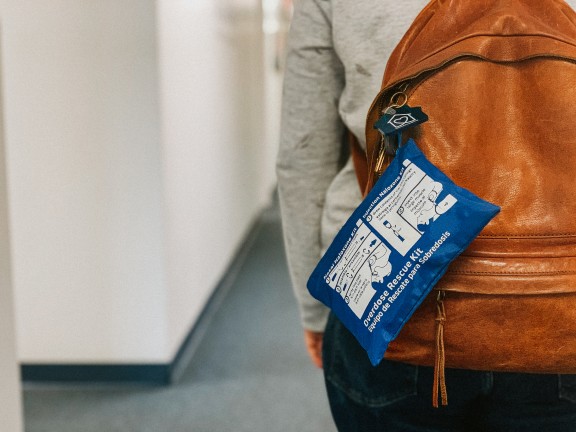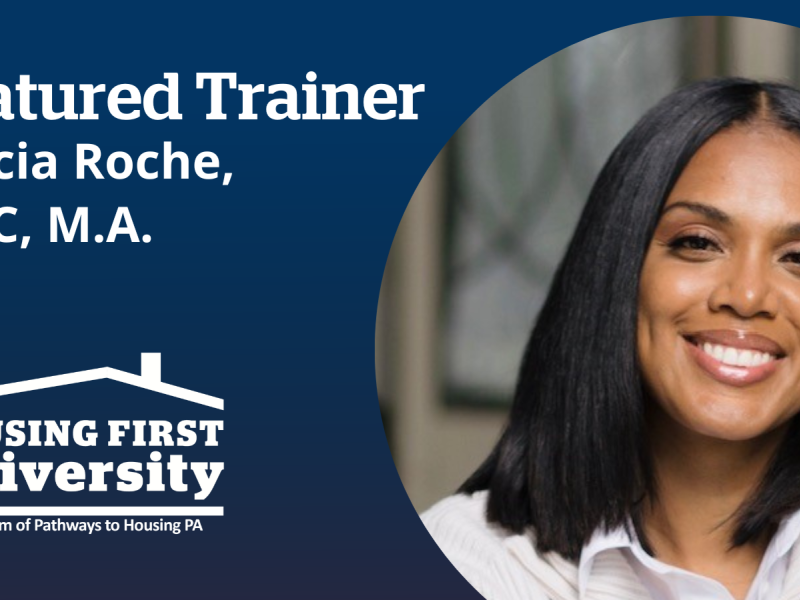I'm Ready to Talk About Overdoses

I'm so tired of talking about Narcan. When I started volunteering at Prevention Point Philadelphia in 2015, I loved it. Each time I used Narcan to reverse an overdose, it felt like a miracle. Training others on how to use it was among my favorite duties. That remained true when I joined Pathways to Housing PA in 2019 as a Substance Use Specialist on one of our teams serving people with opioid use disorder. Asking someone if they had Narcan was my favorite way to say, “your life matters.” It was the best way I knew to tell them, “just because you’re using doesn’t mean you deserve to die” and have them actually hear it—the most powerful language I had for “you have value and I want you around, whether or not you’re sober.” Lately though, as I look at bathroom cabinets full of Narcan and talk to our participants about their past overdoses and our shared experiences of reversing loved ones, the feeling that it’s not enough is becoming overwhelming.
In 2020, there were 1,214 unintentional drug overdose deaths in Philadelphia, more than any year previous save 2017 (when fentanyl first became omnipresent and there were 1,217)¹. Many attribute this to Covid-19, since isolation, uncertainty, and economic insecurity are all recognized drivers of chaotic substance use. International Overdose Awareness Day, on August 31st, is a chance to remember those lost and reflect on how their deaths could have been prevented. It’s also an opportunity to reflect on the experiences of those who have survived overdoses and those who have witnessed them. Overdosing is traumatic even when it isn't fatal. Seeing someone stop breathing is traumatic, even if they start again. Being given Narcan is agonizing for people who are physically dependent on opioids; it throws them into intense and immediate withdrawal. I’ve heard it described as “being hit by a truck and getting the worst flu of your life, at the same time.” Even after those symptoms have dissipated, overdose survivors can be left with a wide range of impairments, including changes in cognition, mood, and memory, resulting from the lack of oxygen available to their brain during the event². Some researchers have even noted a resemblance between the neurological effects of multiple nonfatal overdoses and those of Alzheimer’s Disease³.
So I’m ready to begin talking about the things that will prevent those overdoses from happening in the first place: Things like safe supply programs, where people with substance use disorders are prescribed stable, unadulterated doses of their substance of choice, freeing them from the risks of unexpectedly strong or contaminated batches. These programs, which are already operating in Canada and Switzerland, allow their participants to devote their time and energy to building better lives rather than scrambling for the substances they need to get through the day (whether that need is psychological, physiological, or both)⁴. I’m also ready to talk about cutting away the hurdles that stand between people and methadone, one of the most tried and true treatments for opioid use disorder, but one that has been regulated and stigmatized to the point of inaccessibility for so many who might benefit from it.
I’m more than ready to talk about the larger systemic forces that feed our overdose statistics. No such conversation would be complete without addressing the criminalization of drug use, poverty, and Blackness that cycles people in and out of carceral institutions, recalibrating their tolerance each time. This forces them into a Russian roulette of trial and error to learn their new limits. In the two weeks following release, recently incarcerated people are over 40 times more likely to die from an overdose than members of the general public⁴. These discussions also must speak to the role of housing instability and homelessness. Only just over a third of people experiencing homelessness have chronic substance use issues⁵, but for those people, homelessness is particularly deadly. One study has shown that adults between the ages of 25-44 experiencing homelessness are nine times as likely as their housed counterparts to die of an overdose⁶. When people have safe and secure places to live, they can take their time when they use, instead of going as hard and fast as possible, because who knows when a cop will turn the corner, and the only way to turn off the hypervigilance and constant thrum of vulnerability that can come with homelessness is to get completely wrecked. That sense of vulnerability is well-founded: people experiencing homelessness are violently victimized at much higher rates than the general population. Housed people, unlike the 5,634 Philadelphians documented as experiencing homelessness by the 2020 Point in Time Count⁷, can consider the terrifying/exhilarating prospect of moderating their use or moving toward sobriety with clear eyes after a full, restful night’s sleep and a home-cooked meal. Evidence shows that, given the opportunity, many take up that challenge: 63% of Pathways’ participants with opioid use disorder seek treatment after being housed with us for at least six months, a far cry from the national average of 20%⁸.
I’ve worked with many such participants, but one, in particular, stands out when I consider this topic: J was known among Prevention Point staff for how frequently we administered Narcan to him in our buildings and the surrounding community. An injection heroin user since his early teens, J has also struggled with mental illness since childhood and estimates his lifetime number of overdoses to be in the high double digits. After getting an apartment through Pathways, his opioid overdoses have become increasingly few and far between. This can be directly traced to his involvement in medication-assisted treatment through our Integrated Care clinic, where for the past several months he has been receiving Sublocade, a monthly injection that both prevents opioid withdrawal and blocks the effects of opioid use. Just as crucially, stable housing and the supports of the Pathways’ program have enabled J to begin seeing his life as one worth protecting. While street homeless, J experienced intense hopelessness and despair, regularly expressing a desire to take his life. Even when he wasn’t actively suicidal, he frequently articulated that he did not care if he died so saw no reason to take precautions to protect himself from overdosing. Though he still struggles with depression, suicide no longer comes up in the majority of our conversations, and though he continues to use some illicit substances, he now makes efforts to do so in a way that decreases the accompanying risks to his life and health. No matter how many times he was given Narcan while experiencing homelessness, it wasn’t until he was housed that this shift began to occur.
I don’t mean to imply that Narcan isn’t an important piece of the overdose prevention puzzle. I know I’m coming from a position of privilege, living where I do: with easy access to all the Narcan I could ever need. I’m certainly not going to stop talking about it and shoving it into the pockets and backpacks of anyone who will let me. Seeing government officials, researchers, and policymakers at public health agencies and social service organizations act like Narcan isn’t just a piece, but is the entire puzzle though? It's just making me so, so, so tired. What keeps me going is the knowledge that I am part of a community of advocates and organizations fighting for real, deeper solutions to our current overdose crisis. These include the Drug Policy Alliance, a national organization dedicated to advancing policies grounded in science and compassion that reduce the harms associated with both drug use and the war on drugs, and on the local level, ACT UP Philadelphia, who are currently petitioning Mayor Kenney to make much-needed changes in how the City of Philadelphia serves residents experiencing homelessness. Mark this International Overdose Awareness Day by adding your voice to theirs, by contacting your representatives in support of their campaigns (both organizations have sample letters available on their websites), or through financial contributions. Right now, carrying Narcan with me everywhere and encouraging friends, family, and acquaintances to do the same feels like a moral imperative. This International Overdose Awareness Day, I’ll be thinking about what changes must occur for this to no longer be the case, and what I can do to make them a reality. I hope that you’ll be doing the same.
- Philadelphia Department of Public Health. (2021, June). Unintentional Drug Overdose Fatalities in Philadelphia, 2020 (No. 5). https://www.phila.gov/media/20210603100151/CHARTv6e5.pdf
- Zibbell, J., Howard, J., Clarke, S. D., Ferrell, A., & Karon, S. (2019, September 3). Non-Fatal Opioid Overdose and Associated Health Outcomes: Final Summary Report. ASPE. https://aspe.hhs.gov/reports/non-fatal-opioid-overdose-associated-health-outcomes-final-summary-report-0
- Voronkov, M., Ataiants, J., Cocchiaro, B., Stock, J. B., & Lankenau, S. E. (2021). A vicious cycle of neuropathological, cognitive and behavioural sequelae of repeated opioid overdose. International Journal of Drug Policy, 97, 103362. https://doi.org/10.1016/j.drugpo.2021.103362
- Ranapurwala, S. I., Shanahan, M. E., Alexandridis, A. A., Proescholdbell, S. K., Naumann, R. B., Edwards, D., & Marshall, S. W. (2018). Opioid Overdose Mortality Among Former North Carolina Inmates: 2000–2015. American Journal of Public Health, 108(9), 1207–1213. https://doi.org/10.2105/ajph.2018.304514
- HUD Exchange. (2011, June). 2010 Annual Homeless Assessment Report to Congress. Washington, DC. https://www.hudexchange.info/resource/1872/2010-annual-homeless-assessment-report-ahar/
- Baggett, T. P., Hwang, S. W., O'Connell, J. J., Porneala, B. C., Stringfellow, E. J., Orav, E. J., Singer, D. E., & Rigotti, N. A. (2013). Mortality among homeless adults in Boston: shifts in causes of death over a 15-year period. JAMA internal medicine, 173(3), 189–195. https://doi.org/10.1001/jamainternmed.2013.1604
- Office of Homeless Services. (2021). 2020 Point-in-Time (PIT) Count and Youth Count of People Experiencing Homelessness in Philadelphia. http://philadelphiaofficeofhomelessservices.org/wp-content/uploads/2020/08/2020-Point-in-Time-Count-and-Youth-Count-of-People-Experiencing-Homelessness_8.4.20.pdf
- Pathways to Housing PA. (2021). Annual Report Fiscal Year 2020. https://pathwaystohousingpa.org/sites/default/files/Pathways%20to%20Housing%20PA%202020%20Annual%20Report.pdf


